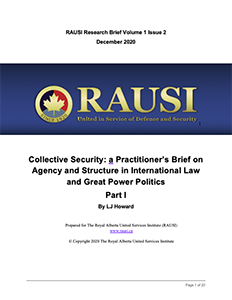Collective Security: a Practitioner’s Brief on Agency and Structure in International Law and Great Power Politics, Part I
International LawLJ HowardBy LJ Howard, 29 December, 2020
RAUSI Research Brief Volume 1, Issue 2
Collective security, alternatively ‘multilateral diplomacy’ or ‘conference diplomacy,’ is best analyzed in a framework of ‘agency and structure’ that synthesizes international law with great power politics. Structure evolved from Westphalia through the Congress of Vienna and League of Nations to the international community of states represented throughout the United Nations. As an international organization, the UN also possesses international personality. Its six principal organs, agencies and collaboration with non-state actors create agency that modulates multilateral diplomacy. The UN’s tackling globalized panoramas of issues, e.g., socio-political, development, cultural, transnational, may pre-empt threats to and breaches of the peace and state aggression. Its executive organ, the Security Council, exercises powers delegated from states that mandate the UN to mitigate these threats under Ch. VII. Part I of the brief diagnoses the need for structure and agency; Part II will diagnose the calculus of Security Council’s Ch. VII powers. Collective security differs from collective defence in scope, intent, law, and resources, yet both may be associated by causality, correlation, or coincidence.

